My first venture in growing bananas is a spectacular success!!
Listen while you read to an informal live take of “Encendido”, one of our new-ish Latin-ish pieces in honor of the inspiration of today’s post. We hope to amass the funds to record an EP of our Latin fusion pieces, but have to pay off the medical bill for Pink’s illness first.
As much as I would have loved to soundtrack this post with Harry Belafonte’s “Day-O”, my policy is to stay with tracks we own all the rights to in order to to avoid a possibly ruinously expensive debâcle. Well, I’ll compromise and add the video bananas have reminded me of since ca. 2001:
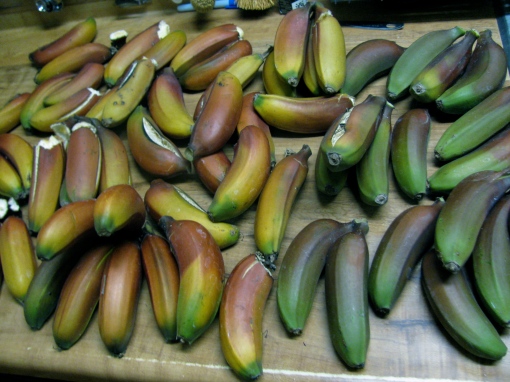
Yes, we don’t have enough bananas!
Banana quote of the day:
“On a traffic light green means go and yellow means yield, but on a banana it’s just the opposite. Green means hold on, yellow means go ahead, and red means where the hell did you get that banana … “
– Mitch Hedberg
Tuesday, March 13, 2012
When we moved to Chinatown about three years ago, the landlord gave us permission to do whatever we wanted with the little front yard (and the house too, but requested that we let him know if we were going to do something big, like knock out a wall – see upcoming post about that demo operation scheduled for this weekend!), so I could finally, at long last, have my very own, real live, in-the-ground culinary garden!! Needless to say, I went nuts, and really struggled to pay off the exorbitant cost. I’m sure it could have been done far less expensively, but I digress as usual.

I first put in the fruit…umm…plants. I know that sounds funny, but they ranged from actual trees (citrus), to bushes (blueberries) and vines or canes (blackberries & raspberries), and then the herbs – the bananas and strawberries. Yes, you read that right — banana plants are not “trees”, they are actually the world’s largest herb!
I had to plan extremely carefully since I crammed all that into an unimaginably tiny space, and still needed to have room left to put veggies and salad and more herbs and flowers, etc. I also researched everything extensively to make sure I put in varieties of plants that would do well in metro L.A.’s very specialized climate.
I can’t remember now whether I wanted bananas independently (most likely), or if I decided I wanted them when I saw all the beautiful banana plants and citrus trees (especially the kumquats!) throughout the neighborhood when we moved in. For the bananas, I found out that there is a truly mind-boggling array of varieties to choose from (look here) and after much deliberation, settled on a dwarf Cuban Red and a Rajapuri. One criteria was that in addition to being delicious, the plant had to be reasonably small. I ordered one corm of each (that’s a root mass with a baby plant, kinda like a bare-root rose bush (actually the baby rose bush I planted at the same time got completely buried under all those tomato plants in the first photo below, but it survived!), and put them in the ground sometime around late March or early April 2009.
The baby plants seemed happy with their new home and grew beautifully. I made sure to feed them and water them well. It turned out that the dwarf variety of the Cuban was indeed not very tall (mature trunk height about 6′, while the standard sized ones average 25′ tall!), but the leaves were enormous and parasol-like in a beautiful deep green with pink-red stems. The Rajapuri was a bit taller and more slender, with a lovely yellow trunk and slimmer leaves that were a pleasing shade of medium green with yellow stems.

Baby Cuban Red banana plant in lower left corner

Young Rajapuri banana plant next to lemon grass in lower left corner. That’s a peacock (or peahen) walking across the street!
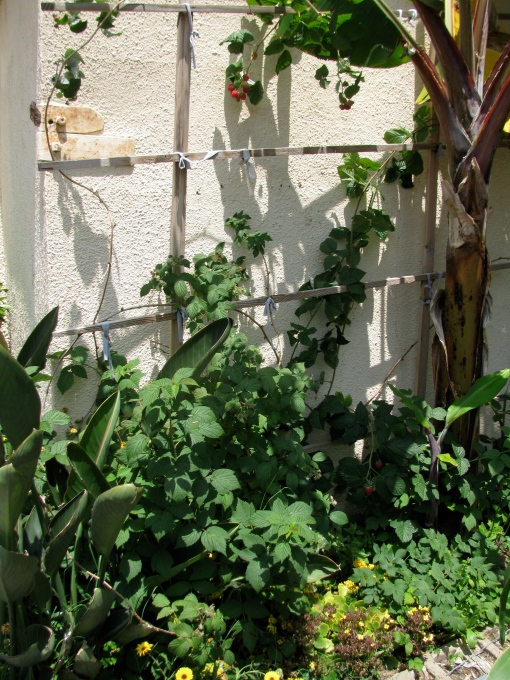
Cuban Red banana plant growing up. It’s next to a south-facing wall that gets good light and lots of reflected heat. That’s a “daughter” plant (yes, the baby plants produced by the “adults” are called that!) coming up at the base, and raspberries are planted next to it.
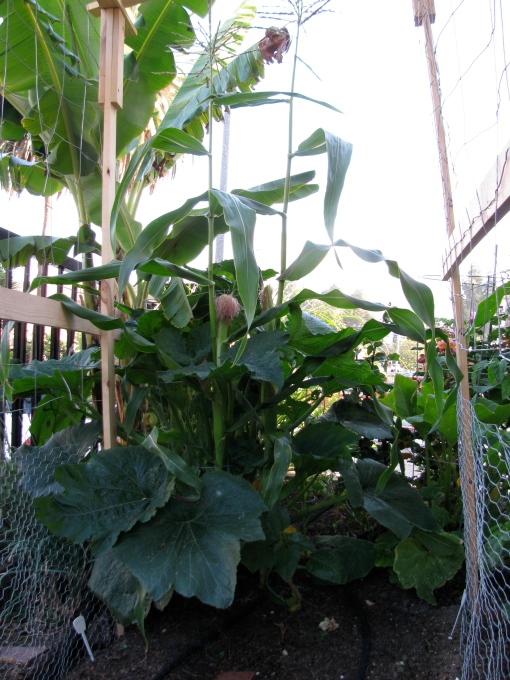
The Rajapuri getting taller (upper right)

Both banana plants growing nicely. I would guess this is around early spring, so the plants would have been for about one year by that point.

View from the street
We found the the unrolling of new leaves particularly fascinating:

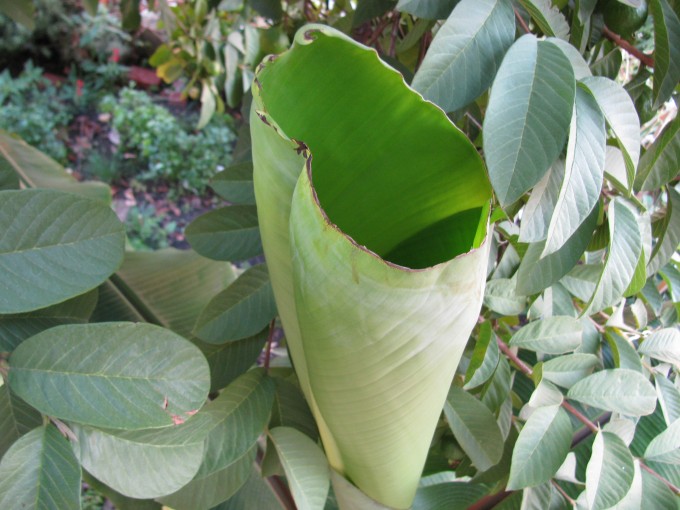





The plants got taller, and since we enjoy barbequing on our front veranda, the huge leaves of the Cuban Red plant made a nice parasol-like sunshade as well as a pretty backdrop:
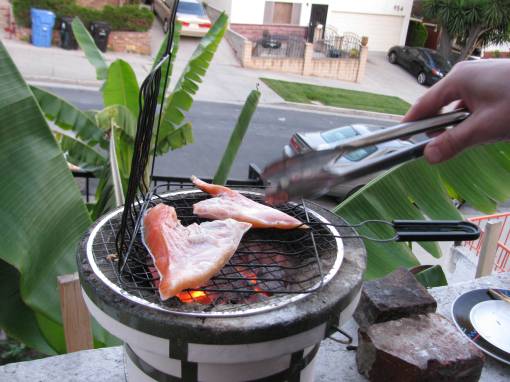
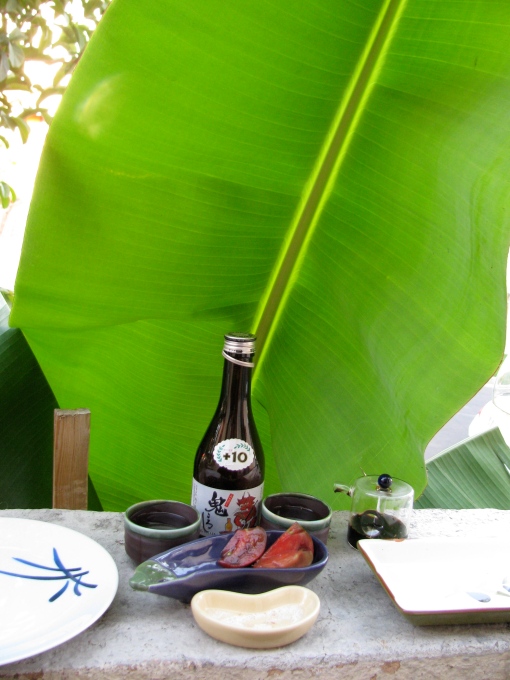

On some occasions, we even had a nice little dinner guest. Earlier that year we had got a few green and grey tree frogs for the garden as an organic pest management measure, and they loved the banana plants.

The little grey spot on the leaf right above the water glass is one of our grey tree frogs who joined us for dinner that evening!
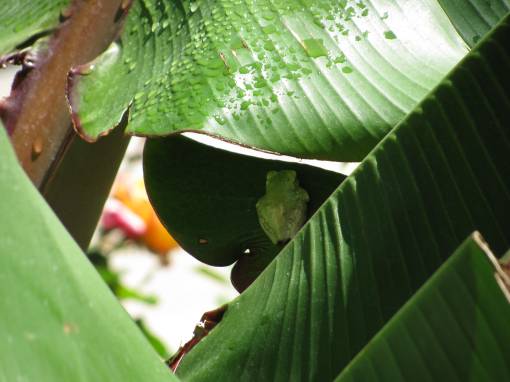
Another little frog seeking shelter from the rain
One day sometime in either late spring or early summer last year, Chi and I were ecstatic to spot a banana stalk, or inflorescence, emerging from the Cuban red. A few weeks later, the biggest of the Rajapuris (three plants grew out of that single corm!) sprouted one too! It took just over two years from when we originally planted the corms. During that time, the Cuban Red had also produced several new plants. The newly blooming banana plants caused quite a ruckus in the neighborhood! (more neighborhood drama caused by the Panache garden fruit trees)


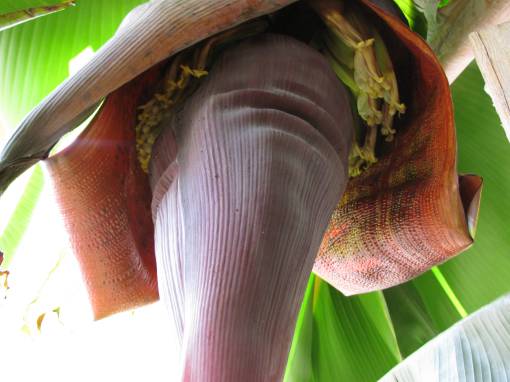
There was a huge wind storm in L.A. back in November, and that absolutely shredded the banana leaves and bent the top of the main stalk of the Rajapuri plant, but it seems to have survived, and I expect that those bananas will be ready soon.

Rajapuri banana plants shredded by huge wind storm in Nov 2011. Note the newly-emerged inflorescence on the second plant! The first one that bent over already has mature bananas on it.
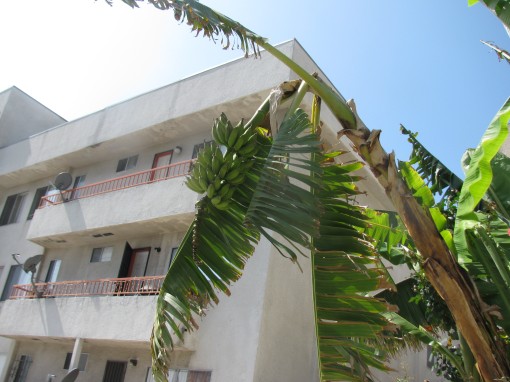
The main stalk of the Rajapuri with bananas got bent during the wind storm, but ended up surviving and the bananas were ok. We’ll harvest those soon!
Anyway, we watched, mesmerized, as the banana stalks evolved and the bananas grew week by week. If my memory is correct, it’s taken about eight or nine months for the fruit to mature enough to be harvested. The Cuban Reds started out deep maroon, and then just about a month ago, they turned green and got rounder. I knew it was time to harvest them when they began turning from green to yellow, but the cat situation so completely consumed my focus that I didn’t get around to it. I did, however, attempt to cut off one hand (what we refer to as a “bunch” of bananas at the grocery store is actually a “hand”. The “bunch” is the whole stalk of them on the plant) to try the bananas the previous weekend. It was more difficult to cut them than I expected. That banana stalk is tough!

Brand-new baby Cuban Red bananas!!

The red outer petioles of the flower curled back and fell off one by one, revealing more and more hands of baby bananas.


The bananas gradually got bigger and the stalk got longer.


By this point, there were only male flowers left under the remaining petioles.
When the stalk stopped producing female flowers (i.e., the ones that turn into bananas), we cut off the terminal bud (that only had male flowers left) at the behest of our neighbors.
When the Cuban Red bananas started turning from yellow back to red-orange again, the tree actually toppled over into the birds of paradise plants as if saying, “Please pick me already!”, so finally on Sunday early evening, Chi and I took the tree saw and I cut the whole stalk off since the bananas were dead-ripe and by that point the skins on over half of them had split open. It’s going to be more challenging harvesting the Rajapuri bananas due to that plant’s location and because the plant is taller, unless that one topples over too.

By the time I took this photo, we had already cut the banana stalk, which was down in the middle of the birds of paradise next to the banana plant. It was really heavy! The big plant next to the toppled-over one is the first “daughter” plant that is all grown up now, and I expect that one will shoot out a flower stalk just about any day now.

This is the colour the bananas were when we harvested them, i.e., “dead-ripe”. They might have held up a little better if we’d harvested them a bit earlier, but boy are they delicious!!
Chi tried one of the Cuban reds and raved about it when I got home from the day job the next day. He said that it tasted just like a milkshake. We shared one for dessert that night and I agree completely: delicious, sweet flavor with no weird aftertaste, and fine texture — the most incredibly beautiful banana I’ve ever seen with its rainbow coloured skin and lovely orange-cream flesh, and the most incredibly delicious one I’ve ever tasted, so my first venture in growing bananas is a spectacular success!! Now we have a s**t-ton of them to enjoy, so I’m looking around for recipes. So far I’ve thought of the following, in addition to just eating them out of hand, of course:
banana pudding
banana cream pie
banana cake/brownies
smoothies
banana bread/muffins
crêpes Suzette
bananas flambé
A shiny new Vitamix is high on my wish list so I can make banana ice cream (and other stuff) too!
Feel free to give me additional suggestions in the comments 🙂

We even had a couple “Siamese Twins” in the bunch! Aren’t they pretty?!

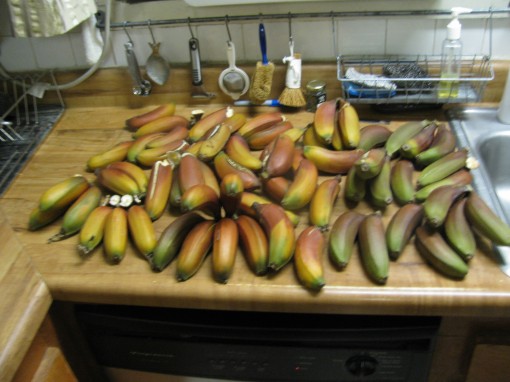
In case anyone feels inspired to try this, here’s a good link about growing banana plants: http://www.tropicalpermaculture.com/growing-bananas.html
P.S. Hey! Did anyone notice the nice, tidy spacing around all the fancy, graphic-y stuff at the top of this post? I learned a new skill: how to use html code to control positioning – hee-hee! Unfortunately I couldn’t figure out how to embed a slideshow though 😦
April 17, 2012 at 06:03
Oh my goodness! You have bananas!?!? I’m not sure how I missed that little fact! How absolutely amazing! How much space do they take up? Man, I am completely envious!!!
LikeLike
April 17, 2012 at 12:10
Thanks for stopping by! Yes, my first attempt with bananas was a smashing success, and now we have some more from the Rajapuri plant! In the photos attached to this post I tried to give some perspective on how much space the banana plants occupy, but that’s more for height. On the square footage side, it must be understood that new plants keep growing up out of the “mat” (root mass), and the “old” plants die off after they produce fruit.
The Cuban Reds are in a contained area (separated from the rest of the yard by a small cinder block barrier) about 2′ wide x 4′ long and the Rajapuris are occupying a slightly smaller area in the “open” part of the yard. Several small plants come up during the lifespan of one big plant, so I guess the banana plots are gradually increasing in size. However you have the option, and in fact are encouraged by growers to cut out a few “pups” to thin out the colony.
From what I understand, there are a few varieties of bananas that could survive in your climate despite the cold. They’re wonderful landscape plants as well as being good to eat 🙂
LikeLike
April 23, 2012 at 11:15
Wow, I am going somewhat bananas over this post, Brenda. How exotic it is you can grow bananas! They must taste divine. I love your photos and your fun little porch where you barbecue. Awesome.
LikeLike
May 1, 2012 at 15:25
Thanks Barbara! We’ve got a million-dollar view of downtown L.A. from our front porch, but I haven’t yet been able to get a good photo of it.
LikeLike
April 23, 2012 at 16:34
I love all the bananas!! My next door neighbor has a little grove of them so once a year we are making lots of banana bread!!
LikeLike
May 1, 2012 at 15:25
Thanks for stopping by, Lisa! I’ll bet Cuban Red bananas grow wild where you live 🙂
LikeLike
September 23, 2012 at 05:01
[…] Panache Garden. The tree has grown quite a bit since we’ve lived here, and between it and the banana plants I put in during our first spring here, they have developed such a dense canopy the past couple […]
LikeLike
September 6, 2013 at 14:41
Heya i am for the first time here. I came across this board and I find
It truly useful & it helped me out a lot.
I hope to give something back and help otyhers like you aided me.
LikeLike
September 9, 2013 at 14:34
Thanks for stopping by!
LikeLike